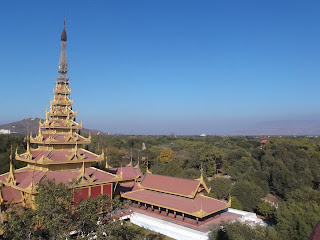
I had read about Bagan in
Burma, and that it was a plain of temples and stupas for as far as you can see. I had even seen photos from the area, of exactly that. But until you see it, I don’t think you really have a concept that there really are temples and stupas EVERYWHERE. I certainly didn’t. So, so many of them! Everywhere you look.
The last count is apparently around 3000 temples still standing, over a 40 square kilometre area – is it any wonder that these inhabitants building these religious monuments for some two and a half centuries are an ancient civilisation – they were clearly not focusing on developing anything but building these temples!

We spent a day and a half exploring the temples of Old Bagan and the outer area of Bagan, and saw just a handful of them. The first day we wandered through the tracks of Old Bagan itself, and then the second day we hired 2 horse and carts, with a great guide, who showed us some of the most amazing ones in a pretty well thought out circuit – including a prime spot for sunset at the end of the day, away from the throngs of tourists trying for the same photo.

From our guesthouse we grabbed a horse and cart to the Tharaba Gate to walk into Old Bagan, and then explored the first two temples on our left, being Shwegugyi and Thatbyrinhyn Temples, which were close to each other. In the first I had a local girl show me some of the features of the temple, as she practiced her English, and hoped I would buy something from her shop at the end. We then wandered along the dirt paths of Old Bagan, checking out some of the smaller temples, before getting to Gawdawpalin for sunset. The white of the temple gave us some gorgeous colours, but alas we could not get to the second level for our shot of the plain in that light.
Instead, we had a couple of beers watching the colours fade on the bank of the Ayerwadday River, at one of the bigger hotels for the view.

The next day we rode around in the back of horse and cart to see about 12 temples, starting with the Shewezigon Pagoda. There are 37 nats, or spirits, and also 9 wonders. Things like the myth or fact that when papers that hold the gold foil that are placed on the Buddha at the centre, are dropping from the height of the pagoda they never fall outside of the temple precinct. Or that when it rains or floods, no water remains inside the compound, and also that when a big drum is beaten on one corner of the walls, it cannot be heard on the other side. So a sign inside told me!
Our day included the most famous of the Bagan temples, being the Ananda, which was indeed very impressive. I think the story of Dhammayangyi was the one that most stood out for me, and again we had a local girl walk along with us and tell us the story of the temple. The design is like a bigger version of Ananda, built later by the most cruellest of rulers – this king demanded that the brickwork be placed so close together that he could not even pass a pin through it – mortarless, they state, although this baffles me as to how it has stayed in place for this long. The story goes that any of those working on the construction failed to manage the super thin space between brick layers, the king cut off his arm – and there are stones where such amputations were completed to be seen. When this king died, the story continues that those slaves made to build the temple filled in the inner pathways in revenge, and now all visitors can only see one of the four openings to Buddha – one for the archaeologists of the future to discover the secrets and treasures within and on the upper and lower floors.

Many of the temples we visited featured well preserved frescos inside, for which you needed a torch to see. Each temple also had a different presentation of Buddha, in terms of hand posture, how he was sitting, and of course, how many there actually were inside. Even the more rural temples were elaborate and ornate inside, as we found when we wandered into temple number 744 on the map, just before we got to our sunset spot for the day.
A seriously impressive and mind-blowing place to visit, we could easily have spent much longer there. Although to be fair, I am happy with our visit and what we did manage to fit it - very wary of the old backpacker issue of being "templed-out". I never thought that state was really possible, but Burma definitely challenges that idea!









































